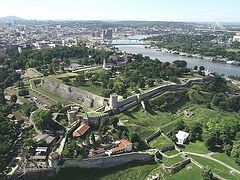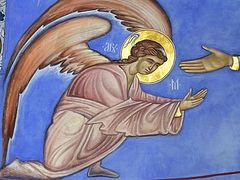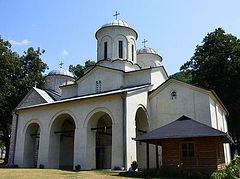What is known about Serbian Orthodoxy to a wide public? Most people only think of two or three names, like Sts. Sava of Serbia, Nikolai (Velimirovic) of Zica and the ever-memorable Patriarch Pavle… Those who visit Montenegro can also recall Ostrog Monastery and St. Basil of Ostrog. Perhaps that is all they know. However, Orthodoxy in the Balkan countries means not only a wealth of spiritual and cultural heritage (little known to many), but also the foundation of the mentality, worldview, the economic, political and spiritual development of the Serbs.
Elena Mitrovic is the wife of a Serbian Orthodox priest. Eleven years ago, she left her life in Moscow behind and with her husband moved to Republika Srpska, which is an entity within Bosnia and Herzegovina. Over these years she has adapted to a new country, grown fond of local traditions and customs, and learned the language. Together with her spouse she raises three bilingual sons. She currently helps her husband, a priest, in his parish activities, makes translations from Serbian, sings in the choir of a Russian cultural center, and runs her Instagram page (@elena_balkanika) where she writes about Orthodoxy in the Balkans, its peculiarities and local church traditions.
Elena gladly agreed to share her insights and observations with Pravoslavie.ru.
—We live in the city of Banja Luka in Bosnia and Herzegovina. It is the administrative center of Republika Srpska, an entity within Bosnia and Herzegovina.
 The monument to holy Passion-Bearer Tsar Nicholas in Banja-Luka
The monument to holy Passion-Bearer Tsar Nicholas in Banja-Luka
My husband is Archpriest Miladin Mitrovic, rector of the Church of St. Basil of Ostrog in Banja Luka. It is one of the largest churches in our city. It is difficult to say exactly how many parishioners we have, but on Sundays and the major feasts our church is always packed.
—A packed church is a cause for joy. Can you tell us more about your parishioners?
—Our parish members are people of different professions and social strata, both simple and well-educated; in a word, the community is diverse. And that is excellent! All of them get along well; all in all, we have a united parish.
—What can you tell us about your family?
—My family consists of my husband, me, and our three sons: Jovan, Alexei and Dmitry. Jovan, our oldest son, was born on the Nativity of St. John (Jovan in Serbian) the Baptist, thus his name was predetermined.
Our oldest children study at a regular public school, and the youngest is still a preschooler.
 The Church of Christ the Savior in Banja Luka
The Church of Christ the Savior in Banja Luka
—What is the life of a priest’s family like in Bosnia and Herzegovina? I have heard that in neighboring Serbia priests are paid by the State. And what about you?
—We are fine here, with the help of God. Local Serbs mostly treat the clergy with considerable respect, which makes us very happy. My spouse is currently busy with the construction of the Russian-Serbian Cathedral in honor of the Royal Martyrs. This temple will symbolize Russian-Serbian friendship, and it is being built in the Russian style. It is no coincidence that it will be dedicated to the Royal Passion-Bearers—the Serbs esteem and love our last Emperor Nicholas II very much; they remember his martyrdom from the hands of godless men and the support he gave to Serbia during the First World War. They are planning to build a Russian cultural center by the cathedral, along with a memorial to Russian volunteers who fought in the Serbian Army in the Bosnian War of 1992–1995 and laid down their lives for the preservation of the Serbian statehood. We hope this cathedral will serve as a token of the Serbian nation’s gratitude to the Russian nation and a symbol of the centuries-old Russian-Serbian friendship.
I can’t say anything for certain about Serbia, but here in Bosnia the State paid the clergy’s salaries for a couple of years; it has since ceased this practice, though.
Apart from the celebration of church services, our priests teach in public schools. That is, the Law of God is a compulsory subject in schools.
—In your view, what is the main difference between the traditions in the Serbian Church and the Russian Church?
—There are some distinctive features in Serbian Church life. Services are celebrated in Serbian, and there are a host of Serbian saints and festivals which are unfamiliar to Russians. In fact, the Orthodox world is so multifaceted and interesting. Serbian Orthodoxy is inextricably intertwined with local history, culture and mentality.
For example, there is the very interesting and even unique tradition of the “Krsna Slava”. It was instituted in the thirteenth century by St. Sava of Serbia, the founder of the Serbian Church: every family was instructed to choose its patron-saint and especially honor his memory, just as every church is dedicated to a particular saint or a feast. This tradition was passed on from generation to generation—every family venerated its “own” family saint—thus the tradition has continued to this day. The “Krsna Slava” is a major holiday in Serbian families, and for many it is even more important than a birthday or name day.
—Ah, that’s why my Serbian relative is not so enthusiastic about birthday greetings, though he is always a grateful person; but he is always indignant with me if I don’t call him in the morning of the feast of St. Nicholas the Wonderworker, when his family celebrates the Slava!
—Exactly! You must greet every Serb on his “Slava” day—all the rest is less important. By the way, it is a three-day event and you can do it during these days.
—Is it true that you can visit people on this holiday without any invitation?
—That is possible in villages and small towns, where festivities are held by whole streets and villages. In cities, as a rule, guests come by invitation. Though you can try and invite yourself over—the Serbs are hospitable and are happy to receive even uninvited guests.
—All the more so because I’ll come with gifts. By the way, what are the most popular gifts in Serbia?
—You can use your own discretion. But among common presents are wine, rakia [a fruit brandy.—Trans.], dishes or something for home use that is beautiful and will come in handy.
—How are relations within Bosnia being built these days? Is there an atmosphere of tension or hostility between Muslims, Orthodox and Catholics? Can Orthodox Serbs feel safe while travelling in the Federation of Bosnia and Herzegovina [one of the two political entities that compose Bosnia and Herzegovina; the other one being Republika Srpska.—Trans.] or should they be prepared for provocations and violence? Are there any Orthodox churches outside Republika Srpska—that is, in the Muslim and the Croatian parts of the country? What state are they in? Who attends them?
—Unfortunately, relationships at a state level still remain rather strained. Of course, there is no open hostility between people, but some tension is still in the air. And there are serious reasons for that.
On the whole, you are free to travel in any part of the country and you will feel safe. If you are friendly and polite, there should be no problems. Though you can run into trouble in some places, and indeed no one can say that we are immune from attacks by hoodlums.
There are quite a few Bosnian Muslims who live in Republika Srpska. Most of them were against the breakup of Yugoslavia and even fought in the Serbian Army in the Bosnian War of 1992–1995. We maintain very good relations with them and there is no discrimination on grounds of nationality. Both Bosnian Muslims and Orthodox Serbs have equal rights; the former can hold high positions and their children go to school together with their Serbian counterparts.
Virtually all Orthodox churches on the territory of Bosnia and Herzegovina were destroyed during that terrible war not long ago. Many of them have been restored (at the expense of the Serbian Orthodox Church), but they still have only a handful of parishioners, if any. After all, virtually all the Serbs were driven away from these lands during the war.
—During my journey through your country I have seen lots of burned, ruined and derelict houses. It was a very depressing sight. I couldn’t help but recall deserted villages of Russia’s Nechernozemye (“the Non-Black Soil Area”, were the land is less fertile). Are these scars from the war, or the impact of “optimization” and urbanization? Why are people leaving the country and where are they going?
—Yes, the ruined houses are grim consequences of the war. People would leave their homes and go somewhere. Or they simple had to flee. Serbs would flee to Serbia or the territories which were controlled by the Serbian Army in Bosnia. The Croats and Muslims would move to Croatia or abroad. European countries (Germany, Austria, Sweden) would receive Croats and Bosnians as refugees during the conflict.
Today, many are still emigrating to Europe and elsewhere from Bosnia, Serbia, Croatia and other Balkan states. Many Balkan republics haven’t yet recovered from the economic crisis caused by the split of Yugoslavia—many factories and plants were closed down, and many economic activities were disrupted. As a result, a lot of people lost their jobs; so unemployment has been a major challenge in this country. Besides, average wages in the EU countries are significantly higher than in the Balkans.
—On a more positive note: Is it true that Serbs show a lot of tender affection for their elderly people and children? Is this treatment any different from what we see in Russia?
—Yes, it is indeed the case. The Serbs’ identity is rooted in traditions and their society is highly patriarchal. They cherish their traditions and family values.
As “northerners”, we, the Russians, are simply more reserved and introverted. I think we too have this love, though we are unable to express our feelings and emotions in such a vivid manner, unlike very open, friendly and emotional Serbs.
—What are you most excited about in Bosnia? And what disappoints you most?
—I am happy to be with my family, in a warm climate, surrounded by sensitive, kind-hearted people.
 A monument to the children killed in the Bosnian War.
A monument to the children killed in the Bosnian War.
What disappoints me is our technological backwardness compared to Russia. Now Bosnia resembles the Russia in the early 2000—many spheres and sectors we have long been used to in Russia are underdeveloped or even don’t exist in Bosnia. I hope it won’t last.
—What do you miss the most?
—Living in Bosnia, I miss my relatives and friends who remained in Russia, I miss the Russian Church and Russian services, and some aspects of the Russian way of life and communication style.
—God willing, the COVID-related restrictions will be lifted sooner or later. Would you recommend Russian tourists to pay more attention to Bosnia? What are the must-see places in this country?
—Yes, definitely. Indeed Bosnia is often undeservedly overlooked by Russian travelers. But Bosnia is a country of stunning natural beauty: mountains and turquoise mountain rivers, valleys, national parks with canyons and waterfalls. Moreover, Bosnia is famous for high-quality rafting. And what about our authentic unique ethno-villages with their traditional industries, tasty and juicy fruits and vegetables, and honey?… I believe it would also be very interesting and useful to come to Bosnia as pilgrims, visiting Gomionica Convent, Liplje and Stuplje Monasteries, the town of Trebinje, with its Tvrdos and Hercegovacka Gracanica Monasteries, and other sites. In addition, the Vrbas River canyon, the Sutjeska National Park, the cities of Banja Luka and Visegrad (famous for its Mehmed Paša Sokolović Bridge), the waterfall in Jajce are worth visiting as well. Fans of outdoor winter sports might be interested in the Jahorina (which hosted alpine skiing competitions during the 1984 Olympics), the Vlasic and Kupres ski resorts. In my blog (@elena_balkanika) I write about Bosnian attractions, among other things.
—What can you say about the life of your church community?
—Permanent parishioners know each other well, so we can say that we make a community. After the Liturgy we all usually stay for coffee and talk with our priest in an informal atmosphere. We organize pilgrimage trips to holy sites of the Balkans. In the city we have an Orthodox youth organization, with lectures, talks with priests and various kinds of ministry. We have no Sunday schools and, as I’ve mentioned above, the Law of God is a compulsory subject in public schools.
—What are the greatest joys of being a priest’s wife? And what difficulties do you have to deal with?
—The greatest joy is that you can be a real support to your husband, a priest, and, in some sense, serve together with him. You need to set an example to those around you, maintaining a good atmosphere in the parish, being kind to everyone, answering the parishioners’ questions, hearing them out and encouraging them. And you should be ready to go with your other half to a small remote town or a village with difficult living conditions—he may be sent there as a priest any moment. Sometimes we have difficult times. But when you know that you serve God, life feels easier and more peaceful. With the help of God we can overcome everything.











